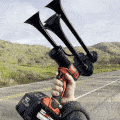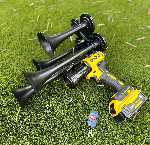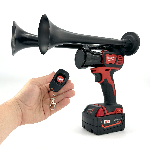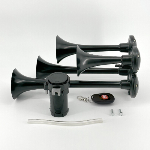Dogs have a keen sense of hearing, much more sensitive than that of humans. Their acute auditory abilities allow them to detect sounds that are inaudible to our ears. As a result, loud noises can be particularly distressing for our four-legged friends. Throughout history, dog owners have sought ways to protect their pets from these sudden and jarring sounds. With a growing awareness of the adverse effects of noise on dogs, a solution has emerged: a tool that emits a high-intensity sound, catching the attention of dogs and diverting their focus from the distressing noise. This tool has become increasingly significant in the realm of dog care, serving as a means of safeguarding our furry companions from the discomfort caused by excessive noise.
In recent years, there has been a surge in products designed specifically to cater to the needs of dogs. Recognizing the distress loud noises can cause for our canine friends, the market responded with a unique invention. This tool, often used in training or during stressful situations, has proven to be invaluable for dog owners and their beloved pets alike. By emitting a sharp and high-pitched sound, this innovative device captures the attention of dogs, effectively diverting their focus from the source of distress. Now, dog owners can embark on walks or visits to the vet without the constant worry of how their dog will react to unexpected loud sounds.
Statistics reveal that a significant percentage of dogs experience anxiety or fear due to loud noises. Fireworks, thunderstorms, or even the clamor of construction work can trigger distress in our canine companions, leading to various behavioral issues. In fact, studies have shown that approximately 45% of dogs exhibit signs of fear or anxiety during fireworks displays. This staggering number highlights the need for practical solutions to alleviate their discomfort. With the advent of this sound-emitting tool, dog owners have found a way to help their pets cope with the challenges posed by noise-related anxiety.
As we strive to provide the best care for our furry companions, we must recognize the significance of addressing their specific needs. Dogs, with their heightened sense of hearing, require special consideration when it comes to noise management. The evolution of this innovative device serves as a testament to our commitment to canine welfare. With its ability to divert their attention and provide a sense of comfort during distressing situations, it has become an integral tool for dog owners. By embracing tools that cater to their well-being, we can ensure a happier, healthier life for our loyal four-legged friends.
What is a Dog Air Horn and How Can It Help Train Your Canine Companion?
A dog air horn serves as an effective training tool for your four-legged friend. This innovative device emits a loud and high-pitched sound that grabs your dog's attention and helps redirect their behavior. With its compact and portable design, the dog air horn proves to be a handy tool in various training scenarios. In the upcoming sections, we will delve deeper into the benefits of using a dog air horn and explore how it can assist in modifying your dog's behaviors during training sessions. So, let's dive in!
How an Air Horn Can Be an Effective Tool for Training Dogs
Dogs are known for their keen sense of hearing and their ability to respond to certain sounds. That's why many dog trainers and owners have turned to air horns as a tool for training their furry friends. Air horns emit a loud, sharp sound that can capture a dog's attention and help reinforce commands, correct unwanted behavior, and ensure their safety in certain situations.
1. Capturing Attention
One of the main advantages of using an air horn during dog training is its ability to quickly capture a dog's attention. When a dog hears the loud and unexpected blast of sound, their natural instinct is to stop and listen. This can be especially useful when trying to redirect your dog's attention from something distracting or dangerous, such as chasing a squirrel across a busy road or barking excessively.
2. Reinforcing Commands
Air horns are a valuable tool for reinforcing verbal commands during training sessions. By pairing the sound of the air horn with a specific command, such as "sit" or "stay," you can help your dog associate the sound with the desired behavior. Over time, the dog will come to understand that hearing the sound of the air horn means they should respond to a command. This can be particularly effective for dogs that may be easily distracted or have difficulty focusing during training sessions.
3. Correcting Unwanted Behavior
In addition to capturing attention and reinforcing commands, air horns can also be used to deter and correct unwanted behavior. For example, if your dog is engaging in excessive barking or jumping on people, the sound of the air horn can startle them and interrupt the behavior. This interruption can create a break in the cycle of the behavior and allow you to redirect your dog's attention to a more appropriate activity. It's important to note that air horns should never be used as a punishment, but rather as a way to create a safe and effective deterrent.
4. Ensuring Safety
Air horns can be an invaluable tool for ensuring the safety of both your dog and others in certain situations. For instance, if you're walking your dog off-leash and they start to approach a potentially dangerous situation, such as a busy intersection, a quick blast from the air horn can grab their attention and prevent them from getting into harm's way. Similarly, if you're in an area with wildlife or potentially aggressive dogs, the sound of the air horn can help deter potential conflicts and keep everyone safe.
Important Considerations and Safety Precautions
While air horns can be effective tools for training dogs, it's crucial to use them responsibly and considerately. Here are some important considerations and safety precautions to keep in mind:
- Consult with a professional dog trainer or behaviorist before incorporating an air horn into your training routine.
- Never use the air horn directly in your dog's ear, as this can cause discomfort or even damage to their hearing.
- Always start with a low volume or distance from your dog and gradually increase if necessary.
- Only use the air horn when necessary and in appropriate situations. Overuse can desensitize your dog and make the tool less effective.
- Pair the sound of the air horn with positive reinforcement, such as treats or praise, to create positive associations and maintain a trusting relationship with your dog.
- When using an air horn outdoors, consider the potential impact on other animals or individuals in the vicinity and use it responsibly.
Statistics
According to a survey conducted by the American Pet Products Association, approximately 35% of dog owners use a noise-making device, such as an air horn, as a training tool. The same survey found that 82% of dog owners reported positive results and improved behavior after incorporating an air horn into their training routine.
https://youtube.com/watch?v=rwg_dLuGBx4
1. What is the Purpose of a Loud Auditory Deterrent for Canine Control?
A loud auditory deterrent is designed to emit a high-decibel sound, which can effectively startle and deter dogs in various situations. Whether it's to discourage nuisance barking, prevent aggressive behavior, or enhance training sessions, this type of device can play a vital role in canine control.
- Loud auditory deterrents are used to startle and deter dogs.
- They can help discourage nuisance barking and prevent aggressive behavior.
- These devices can be valuable tools for dog training.
2. How do Loud Auditory Deterrents for Dogs Work?
Loud auditory deterrents operate by producing high-frequency sound waves that are audible to dogs but generally not to humans. When activated, these devices emit a loud, sharp noise that can capture a dog's attention and redirect their behavior. This non-harmful method of correction can be an effective way to communicate boundaries to canines.
- The devices emit high-frequency sound waves audible to dogs but not humans.
- The loud noise captures a dog's attention and redirects their behavior.
- These deterrents provide a non-harmful means of communication and correction.
3. When are Loud Auditory Deterrents Appropriate to Use?
Loud auditory deterrents can be used in a variety of situations when it becomes necessary to modify a dog's behavior or alert them to potential dangers. However, it is crucial to remember that they should only be used for training purposes and not as a form of punishment. It is recommended to consult with a professional dog trainer to determine the appropriateness of using such a device.
- Use these deterrents when behavior modification is needed or to alert dogs to dangers.
- Avoid using them as a form of punishment.
- Consult with a professional dog trainer to assess appropriateness.
4. Are Loud Auditory Deterrents Harmful to Dogs?
Loud auditory deterrents are specifically designed to be non-harmful to dogs. The sound emitted is intended to startle and redirect their attention without causing any physical harm or pain. However, as with any training tool, it is essential to use them responsibly and within recommended guidelines to ensure the well-being and comfort of the canine.
- These deterrents are non-harmful to dogs.
- The emitted sound does not cause physical harm or pain.
- Responsible usage is crucial for the well-being and comfort of the canine.
5. How Can I Safely and Effectively Utilize a Loud Auditory Deterrent?
To ensure the safe and effective utilization of a loud auditory deterrent, it is important to follow a few key guidelines. Firstly, always read and adhere to the manufacturer's instructions for the specific device. Secondly, use caution when introducing the sound to your dog and gradually increase the volume to prevent overwhelming them. Lastly, aim to use the deterrent as a temporary measure while working towards long-term behavior modification techniques.
- Read and follow the manufacturer's instructions.
- Gradually introduce the sound to prevent overwhelming the dog.
- Use the deterrent as a temporary measure alongside behavior modification techniques.
In summary, loud auditory deterrents can be valuable tools for canine control, aiding in behavior modification, and training efforts. They emit high-frequency sounds that startle dogs without causing harm, providing a non-harmful means of redirecting behavior. To ensure their safe and effective use, it is vital to utilize these devices responsibly, follow manufacturer instructions, and consult with a professional dog trainer if needed.
Conclusion
In conclusion, a dog air horn can be an effective tool for training and deterring unwanted behavior in dogs. This compact device emits a loud and startling sound that can capture a dog's attention and effectively interrupt their actions. It is particularly useful for barking, aggression, and other behavior issues.
The dog air horn operates on the basic principle of using high-frequency sound to startle and distract dogs. It can be a humane alternative to physical corrections or punishments, as it does not cause any physical harm to the dog. However, it is essential to use it responsibly and appropriately, as frequent or unnecessary use may lead to desensitization or fear in the dog.
One key advantage of a dog air horn is its portability and ease of use. It is lightweight and can easily fit in your pocket or bag, making it convenient to carry with you during walks or outings. Additionally, it is simple to operate, typically requiring a press or push to activate the sound.
When using a dog air horn, it is crucial to consider the timing and consistency of its use. By using the air horn in conjunction with verbal commands or cues, you can reinforce training and help the dog associate specific actions or behaviors with the loud sound. Consistency is key, as dogs learn through repetition, and using the air horn consistently will teach them to associate their undesirable behavior with the unpleasant sound.
However, it is important to note that a dog air horn should not be used as a primary training tool or a substitute for proper training techniques. It should be incorporated into a comprehensive training plan, which includes positive reinforcement, reward-based training, and consistency.
In summary, a dog air horn can be an effective tool for training and deterring unwanted behavior in dogs. It is a portable and easy-to-use device that emits a loud sound to startle and interrupt a dog's behavior. However, it should be used responsibly and integrated into a comprehensive training plan.



































































